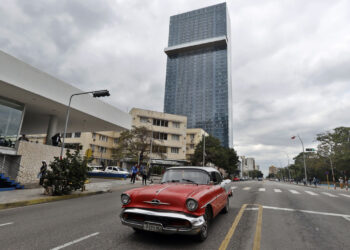Havana people sometime miss a suggestive proposal, which generates debates. This is the kind of brain lethargy that informed public automatically refuse when knowing about an exhibition of plastic artist Lázaro Saavedra (Havana, 1964). Neural systems get i nstantly activated, which promote empathic approach to irony, the triple meaning and sophisticated and intelligent ” mocking”. His outstanding career justifies it, both for his participation in collective creation experiences as ¨Puré and Enema¨, as in his constant morphological renewal through foray into the technological art, a keen aesthetic of “junks” or through the use of a caustic, colloquial and anarchic humor.
Saavedra is an artist who has continually indigested the systemic mechanisms that promote paralysis and absorption of artistic discourses, even those that at first seemed the most daring and rebellious ones. “Altar de St. Joseph Beuys” ( 1989), “Con la fuerza del ejemplo” (1993) or “El detector de ideologias” (1989) are some of his flagship samples in this regard. These works exemplify, in my opinion, the bold aim of promoting the exact idea at the neuralgic moment. Dates tell a story, the reader just have to consult the individual parts of the socioeconomic and cultural events of the last decades.
The sample “Sin concepto” (September 11-October 18, 2013) that Saavedra exhibits at Havana Gallery is a tantalizing puzzle, there is nothing more disconcerting than a principle statement: “This exhibition has no concept and is poorly cared. The artist and the gallery are not liable to the consequences it may bring to your mental stability. “What can I say about the unintended reflections or, to use a less tainted term, deconstructions that disinhibit a proposal like this, capable of threatening the “mental stability” of inflexible or Orthodox visitors? When scrutinizing the various pieces included here, few concepts or schemes are left immune.
Let us analyze first the text recurrence in shaping the work, to be consistent with its post-conceptualist perspective, sometimes cynical, of art and society. Such is the case of “Debajo de esta palabra se esconde un gran concepto” (2013) or “Detrás de esta obra lo que hay es mierda” (2013). In both cases Saavedra recurred to the famous “stupidity” in the usual processes of consumption and interpretation of art, when hindering elementary senses raised by the work, due to an inevitable snobbery anxiety or disparagement of the value of a simple and strong idea.
The argument is different in “Cuban Software” (2012), where he showed a synoptic table that recalls the rigid systematization of Cuban ideological currents very studied during the nineteenth century. Only that this is an insolent binnacle of the thin margins through which the political-ideological choices of today’s Cuban run, peripatetic discovery of an essential truth: cornered to the daily struggle for survival, the Cuban social subject has a very narrow possibility of will. The genesis of its own perpetuation is in the logical negation of political schemes vertically defined from the youth of my parents.
the texts that accompany in form of graffiti most of the proposals of “Sin concepto” are used in another sense as side notes that create a kind of paranoid image, the artist, once the assembly process is finished, gets undressed of himself and becomes alter ego saboteur and corrosively questions, undermines, opposes to unanimous pandemic and decides to do something new with his thinking. And this Dadaist gesture is particularly merciless with the inflated and demagogic use of the speech. I’m talking about a specific type, the one of “Hombre que se alimentaba de monologo” (2012) or “Narcigogia” (2013), auto complacent recurrence to mass media manipulation, the hegemony of the verb, or the comprehensive masturbation of crystallized slogans.
Some of these creations are historical records or files of a work that the artist brings up in this year. This is the case of “Karl Marx”, a recreation of a caricatured image in mixed technique on cardboard (1987), presented as a poster (1992), recorded on screen (2000) and sculpted (2013). Incisive critical reviews to which are subject the ideologies and doctrines over time, determine a natural and dialectical process. The work is leitmotif of itself, but it is more complex at each occurrence: let us take note conscientiously of the signs of its metamorphosis. A case also relatable in this item would be “El detector de ideologias “(1989-2013), “which does not work due to lack of parts.”
That insistent re-contextualization becomes very personal in a concluding play: “Mima” (2013). This piece comes as anthropological memory of a recent past, the decades of the ’70- ’90 of the last century in Cuba: the enthusiastic affiliation to organizations, inclusivist pretension, sleepless and vigilant fervor, socialist emulation … Its morphology refers to chaotic structure of murals that emerged and still survive in workplaces, CDRs (Spanish acronym for Committees for the Defense of the Revolution) and cooperatives; palimpsests of news, events, optimistic overfulfillments. On the wall we appreciate photographs, diplomas, awards, payment receipts, rationing notebooks … in the end, the reconstruction of the family, social and historical biography of a person, which is also the one of a generation.
Sometimes comments are not needed when images left us speechless, with the serene confidence of those having this feeling in themselves. We could include concepts also in this list. We might as well let them on a platform or maybe build a place of honor for them. Forgetting is, after all, always harmful.
1. This artist usually makes versions of some of his works in various mediums, formats and varying certain elements through which he achieves a sort of procedural work, which explains why some of his pieces are dated from time intervals [Information confirmed by Brilly Nande Perez, representative and wife of the artist, whom I thank for her kind collaboration).










